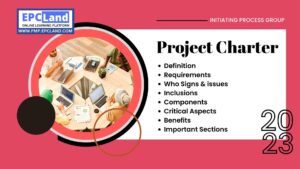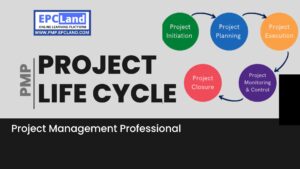One of the most in-demand skills in project management is the ability to launch projects effectively. Defining the project, securing the necessary funding, and establishing communication with stakeholders are important aspects of starting a project. The PMBOK® Guide provides a powerful model for ensuring the overall success of successfully launching a project systematically. Following best practices from the PMBOK® Guide, the Initiation Process Group contains the following major interconnected components:
Understanding the project management initiating process group
A process performed to define a new project or phase of an existing project by obtaining approval to start the project or phase. Within the initiation process, the initial scope is defined, and the initial funding is committed. Internal and external stakeholders that influence and influence the overall outcome of Project are identified. A project manager is selected if not already assigned. This information will be recorded in the project charter and stakeholder register. Once the project charter is approved, the project is officially approved. The project management team can help develop the project brief, but approvals and funding are handled outside the project boundaries.
As part of the initiation process group, many large or complex projects can be broken down into separate phases. In such a project, the initiation process is carried out in subsequent phases to validate the decisions made in the initial processes Develop Project Outline and Identify Stakeholders. By invoking the initiation process at the beginning of each phase, you can focus your project on the business needs of the ongoing project. Success criteria are checked, and the influence and goals of project participants are checked. Then decide whether to continue, postpone, or cancel the project.
Attempt Quiz-1 on Initiating Process Group
Involving customers and other stakeholders at the start increases the likelihood of shared ownership, acceptance of results, and customer and other stakeholder satisfaction.
Process initiation can be through organizational, program, or portfolio processes outside of the project’s control. The feasibility of new projects can be determined through a process of evaluating alternatives. A clear statement of the purpose of the project is developed, including why the particular project is the best alternative to meet the requirements. This decision document may also include initial statements regarding project scope, results, project duration, and resource projections for the organization’s investment analysis. As part of the initiation process, project managers are empowered to use organizational resources for subsequent project activities.
Create a project Charter during project management initiating process group
Developing a project charter is the process of formalizing a project or phase and creating a document that documents the initial requirements to meet stakeholder needs and expectations. A charter ties the project to the ongoing work of the organization and authorizes the project. Projects are chartered and approved outside the project by an organization, program, or portfolio management agency. Multi-phase projects use this process to validate or improve decisions made during previous development project charter iterations.
In short, Project assignments help project managers define project boundaries so that all expectations and goals are clear from the start. Stakeholders and other key players are included in communications to enhance long-term project success and clarify initial and long-term goals. Phase decisions are made so that timelines and outcome benchmarks can be established. While taking place outside the official project boundaries, all funding sources must be established and approved before the project charter is presented.
Attempt Quiz on Project Charter
Identify stakeholders in project management initiating process group
Stakeholder identification is the process of identifying individuals or organizations affected by a project and documenting relevant information regarding their interest, involvement, and impact on the success of the project. This process connects the project to the people or organizations affected by the project and ensures the success of the project. Stakeholder identification is necessary to manage stakeholder expectations and influence related to project requirements. Because stakeholder identification is an iterative process, the results of this process, the stakeholder register, and the stakeholder management strategy should be revised at subsequent stages of the project.
In short, Identifying and quantifying all stakeholders and other stakeholders affected by the project is critical to ensuring a plan is in place to mitigate the “backtracks” that can slow the project. Understanding the key stakeholders and identifying the surrounding circumstances that may hinder the project’s success are important investments of time and energy that project managers spend in the early stages of a project. Considering the stage parameters and making careful predictions at this stage can help project managers plan future actions such as: For example, introduce training sessions, announce planned downtime, and address potential customer concerns before a new phase of a project begins.
Attempt Quiz on Project Stakeholders
What are the activities of the Project Management Initiating process group?
In the Project Management process group, the activities in the Initiation process group are primarily aimed at successfully initiating a project. It also triggers the activities in the Planning process group when the project initiation is complete. In this article, we’ll look at the initiation process group activities one by one.
1- Project manager selection during project management Initiating process group:
This is the first activity in this Project Management process group. Once it is clear that the project will begin, the project sponsor, the person who will financially support the project, must decide on procedures and procedures.
Assigning a project lead to a project is her one of the first steps. A project manager is the primary person responsible for and coordinator of project management activities.
2- A company’s organizational structure, tools, procedures, and policies influence projects progress. For example, if you have a procedure for assigning tasks to project team members, you should specify this at the start.
3- Gather process, procedure and historical information during the Project Management Initiating process group:
Processes used to manage projects are collected. If there have been similar projects in the past, or if there are lessons learned that can be incorporated into current projects, these are searched for in the company’s organizational process assets.
Attempt Quiz-2 on Initiating Process Group
4- Divide large projects into phases during the project management Initiating process group:
If the project is very large, dividing it into smaller phases makes it easier to target, manage, and coordinate the project. It also makes it easier to monitor and control project activities. Therefore, large, long-term projects should be evaluated as to whether these projects can be implemented in phases.
5-Understanding of the business scenario during the project management Initiating process group:
This is very important. Because the project business case defines why the project is started. A project is considered failed if, at the end of the project, it does not meet the reason why it was started. Therefore, you should always keep the project’s business case in mind when defining your project’s goals.
6- Clarify the initial requirements and risks in project management initiating process group:
Customer requirements are collected and these requirements are detailed later in the planning process. Similarly, any project risks identified during the initiation phase should be documented. If there are response strategies, they should also be documented. Later in the planning process, project risks and their response strategies are assessed in detail.
7- Create measurable goals when starting the project management initiating process group:
Project goals should not be subjective. For example: “We will develop a camera for smartphones that can take good pictures.” Is it a measurable goal? A good picture for one person may not be good enough for another. However, setting a goal, he said, “I will develop a camera for smartphones that can take pictures at 32 megapixels.” 32 megapixels is a quantitative goal for the project, so this is measurable.
8- Development of project assignments during project management initiating process group:
The project order contains general information about the project. Sponsors are responsible for creating project orders, while project managers can create project orders on projects.
9. Identify stakeholders during project management initiating process group.
This is another important activity in the Start Project Management process group. Strong and influential stakeholders can have a significant impact on how a project progresses. Therefore, stakeholder expectations and requirements must be documented and properly managed throughout the project for the success of the project.
10- Develop a stakeholder management strategy during project management initiating process group.
All stakeholders have different expectations and requirements for the project. Also, different stakeholders require different approaches. A proper stakeholder management strategy should be developed, especially for the strong and influential project stakeholders.
After completing the activities in the Initiate Project Management process group, the planning phase begins.
Summary on project management initiating process group
By cautiously building undertaking inputs, along with getting ready the undertaking constitution and placing procurement wishes in place, it’s miles viable for a undertaking supervisor to set a undertaking up for long-time period fulfilment. Communicating with important components to evaluate environmental elements and organizational methods that would regulate undertaking fulfilment is an crucial step to take which will create a whole undertaking constitution viable. At the identical time, knowledge the interaction of essential and minor stakeholders via the stakeholder registry technique is a complementary undertaking important to help a fantastic tone and clean verbal exchange because the undertaking unfolds.
Tending to the information of the Initiating Process Group units the undertaking momentum in development and creates a complete technique to logically and carefully dealing with the duties that want to be finished earlier than a undertaking actions into complete swing. Across all industries, the method of the PMBOK® Guide may be implemented and tailored to decorate the effectiveness of undertaking managers in any respect levels.
















